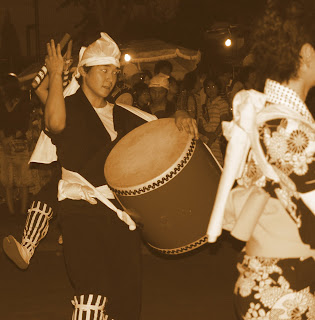Officials made the decision following a board of directors meeting in Nagoya and a meeting to determine the rankings for the September Grand Sumo Tournament.
Kotomitsuki, whose real name is Keiji Tamiya belongs to the Sadogatake stable. He is the 16th wrester in the Heisei period to be promoted to the rank of ozeki, after Hakuho was given the rank following last year's spring tournament. At 31 years and 3 months, he is also the oldest wrestler to be promoted to the rank of ozeki since the system of six tournaments per year was established in 1958. The previous record was held by Masuiyama, who was 31 years, 2 months old at the time.
Kotomitsuki accepted the promotion without hesitation, "I respectfully accept. At all times I will fight with all my might, and devote myself to the path of sumo," the wrestler said. (Mainichi)
Originally a Nenbutsu folk dance to express the effusive welcome for the spirits of the dead, the style of celebration varies in many aspects from region to region. Each region has a respective local Bon dance, as well as respective music accompanying the dance. The music accompanying the dance can be songs specifically pertinent to the spiritual message of Obon, or local min'yo folk songs. Consequently, the Bon dance will look and sound different from region to region.
The dance of a region can depict the area's history and specialization. For example, the movements of the dance of the Tanko Bushi (the "coal mining song") of old Miike Mine in Kyuusu show the movements of miners, i.e. digging, cart pushing, lantern hanging, etc. Because everyone dancing performs the same feet and hand movements in unison, it really is an interesting and beautiful dance to behold.
There are other ways in which a regional Bon dance can vary. Some dances involve the use of different kinds of fans, others involve the use of small towels called tenugui which may have colorful designs. Some require the users to use small wooden clappers they use during the dance. The "Hanagasa Odori" of Yamagata is particularly interesting, for its dancers use a flower-decorated hat or "hanagasa" for the dance.
The music that is played during the Bon dance is not limited to Obon music and min'yo; some modern enka hits and kids' tunes written to the beat of the "ondo" are also used to dance to during Obon season. Particularly famous is "Pokemon Ondo", which was used as one of the ending theme songs for the Pocket Monsters anime series in Japan.
The Bon dance tradition is said to have started in the later years of the Muromachi period as a public entertainment. In the course of time, the original religious meaning has faded, and the dance has become associated with summer.
Lots of good food with fun and games for the kids and adults alike.
The below is a picture of Imiah san (spelling?) and Sally--the host of our pre-bon Odori festival festivities.
Bon Odori originates from the story of a Buddhist disciple who envisioned his deceased mother in the Realm of Hungry Ghosts where she was endulging in her own selfishness. Greatly disturbed, he went to Buddha and asked how he could release his mother from this realm.
Buddha advised his disciple to perform some charitable act in memory of his mother. The disciple did this and, thus, saw his mother's release for the Realm of Hungry Ghosts.
The way in which the dance is performed is also different in each region, though the typical Bon dance involves people lining up around a high wooden building made especially for the festival called a 'yagura'. The yagura is usually also the bandstand for the musicians and singers of the Obon music. Some dances proceed clockwise, and some dances proceed counter-clockwise around the yagura. Some dances reverse during the dance, though most do not. At times, people face the yagura and move towards and away from it. Still some dances, such as the Kagoshima Ohara dance, and the Tokushima Awa Odori, simply proceed in a straight line through the streets of the town.This Buddhist dance festival is celebrated as a reminder of the gratefulness one should feel toward their ancestors.
The Woman on the left below is Imiah san's wife. Imiah san is a very famous photographer.
To celebrate O-Bon in Okinawa, the eisa drum dance is performed instead.
Well, that is all I got. Hope it is well received.
:j





























2 comments:
Jas,
Thank you so much for giving us a taste of Japanese culture.The pictures are wonderful.Everything is so colorful.What a great education you are getting-nothing you could get out of a book.
Thanks for sharing your experience.
Love
Mom
Ok - I want a kimono too- do they make xxl ones? Oh they are so beautiful- the clothing ,people and their traditions and culture-soak it up all you can.
We love u more
Aunt Patti & Robert
Post a Comment